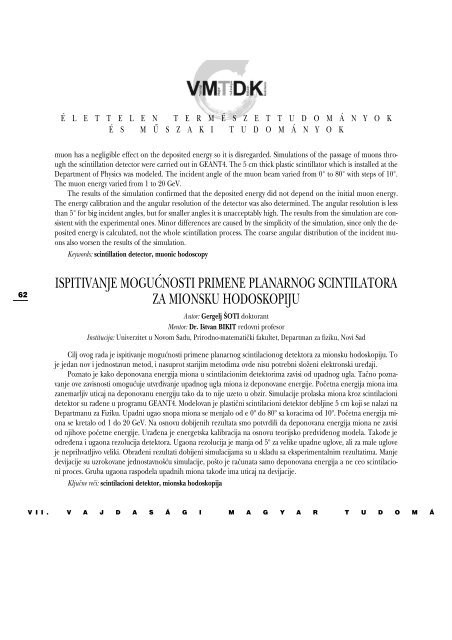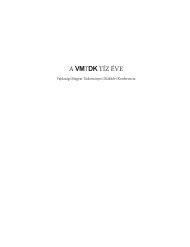Rezümékötet 2008. - vmtdk
Rezümékötet 2008. - vmtdk
Rezümékötet 2008. - vmtdk
Create successful ePaper yourself
Turn your PDF publications into a flip-book with our unique Google optimized e-Paper software.
62<br />
É L E T T E L E N T E R M É S Z E T T U D O M Á N Y O K<br />
É S M Û S Z A K I T U D O M Á N Y O K<br />
muon has a negligible effect on the deposited energy so it is disregarded. Simulations of the passage of muons through<br />
the scintillation detector were carried out in GEANT4. The 5 cm thick plastic scintillator which is installed at the<br />
Department of Physics was modeled. The incident angle of the muon beam varied from 0° to 80° with steps of 10°.<br />
The muon energy varied from 1 to 20 GeV.<br />
The results of the simulation confirmed that the deposited energy did not depend on the initial muon energy.<br />
The energy calibration and the angular resolution of the detector was also determined. The angular resolution is less<br />
than 5° for big incident angles, but for smaller angles it is unacceptably high. The results from the simulation are consistent<br />
with the experimental ones. Minor differences are caused by the simplicity of the simulation, since only the deposited<br />
energy is calculated, not the whole scintillation process. The coarse angular distribution of the incident muons<br />
also worsen the results of the simulation.<br />
Keywords: scintillation detector, muonic hodoscopy<br />
ISPITIVANJE MOGUÆNOSTI PRIMENE PLANARNOG SCINTILATORA<br />
ZA MIONSKU HODOSKOPIJU<br />
Autor: Gergelj ŠOTI doktorant<br />
Mentor: Dr. Ištvan BIKIT redovni profesor<br />
Institucija: Univerzitet u Novom Sadu, Prirodno-matematièki fakultet, Departman za fiziku, Novi Sad<br />
Cilj ovog rada je ispitivanje moguænosti primene planarnog scintilacionog detektora za mionsku hodoskopiju. To<br />
je jedan nov i jednostavan metod, i nasuprot starijim metodima ovde nisu potrebni složeni elektronski ureðaji.<br />
Poznato je kako deponovana energija miona u scintilacionim detektorima zavisi od upadnog ugla. Taèno poznavanje<br />
ove zavisnosti omoguæuje utvrðivanje upadnog ugla miona iz deponovane energije. Poèetna energija miona ima<br />
zanemarljiv uticaj na deponovanu energiju tako da to nije uzeto u obzir. Simulacije prolaska miona kroz scintilacioni<br />
detektor su raðene u programu GEANT4. Modelovan je plastièni scintilacioni detektor debljine 5 cm koji se nalazi na<br />
Departmanu za Fiziku. Upadni ugao snopa miona se menjalo od e 0º do 80º sa koracima od 10º. Poèetna energija miona<br />
se kretalo od 1 do 20 GeV. Na osnovu dobijenih rezultata smo potvrdili da deponovana energija miona ne zavisi<br />
od njihove poèetne energije. Uraðena je energetska kalibracija na osnovu teorijsko predviðenog modela. Takoðe je<br />
odreðena i ugaona rezolucija detektora. Ugaona rezolucija je manja od 5º za velike upadne uglove, ali za male uglove<br />
je neprihvatljivo veliki. Obraðeni rezultati dobijeni simulacijama su u skladu sa eksperimentalnim rezultatima. Manje<br />
devijacije su uzrokovane jednostavnošæu simulacije, pošto je raèunata samo deponovana energija a ne ceo scintilacioni<br />
proces. Gruba ugaona raspodela upadnih miona takoðe ima uticaj na devijacije.<br />
Kljuène reèi: scintilacioni detektor, mionska hodoskopija<br />
V I I . V A J D A S Á G I M A G Y A R T U D O M Á




